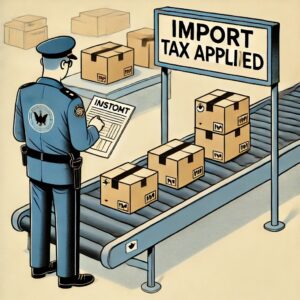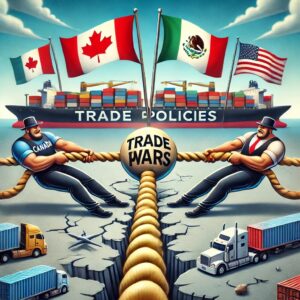Introduction
Recent policy changes introduced by President Donald Trump have imposed significant tariffs on e-commerce imports from China, Mexico, and Canada. These new tariffs, including a 25% duty on imports from Canada and Mexico and a 10% duty on Chinese goods, are set to have widespread consequences for businesses that rely on global supply chains. In particular, e-commerce businesses importing products into the U.S. will face increased costs, supply chain disruptions, and regulatory changes. This article will explore the impact of these tariffs and strategies businesses can implement to mitigate their effects.

The Rising Costs of Tarrifs on E-commerce Imports
For businesses engaged in cross-border e-commerce, these new tariffs mean a sharp increase in costs. The higher duties apply to a wide range of goods, including electronics, apparel, and everyday consumer products. Companies that rely on imports from these countries will need to adjust their financial planning to accommodate these changes.
Tarrifs on E-commerce Imports Affect Pricing
- Higher consumer prices: Businesses may be forced to pass on higher costs to consumers, leading to increased retail prices and potential demand slowdowns.
- Reduced profit margins: If businesses absorb the extra costs instead of passing them on, their profitability will decline, particularly for low-margin goods.
- Reevaluating suppliers: Some e-commerce sellers may need to explore alternative sourcing options to avoid high tariff costs.
In addition to these financial implications, businesses must also navigate evolving trade policies that could further complicate operations.

Supply Chain Disruptions and Logistics Challenges
The new tariffs on e-commerce imports will likely create supply chain challenges for businesses that depend on imports from China, Canada, and Mexico. Many companies will need to rethink their fulfillment and distribution strategies to minimize disruption.
How Tariffs on E-commerce Imports Impact Warehousing and Distribution
- Delays in shipments: With tariffs on E-commerce imports making products more expensive, some companies may experience delays as they adjust their supply chain logistics.
- Changes in fulfillment center operations: Warehouses and e-commerce fulfillment centers must prepare for increased inventory costs and potential shifts in storage demand.
- New regulatory requirements: The suspension of the “de minimis” exemption means that low-value shipments under $800 will now be subject to duties, significantly impacting tarrifs on e-commerce imports.

Retaliation and Future Implications for E-commerce Businesses
A major concern surrounding these new tariffs on e-commerce imports is the potential for retaliatory actions by Canada, Mexico, and China. Both Canada and Mexico have announced plans to impose their own tariffs on U.S. goods, which could lead to further economic instability for e-commerce businesses operating internationally.
Adapting to the Changing Landscape of Tariffs on E-commerce Imports
To remain competitive in this evolving landscape, businesses should consider:
- Exploring alternative suppliers in countries not affected by these tariffs.
- Reevaluating pricing strategies to balance competitiveness and profitability.
- Staying informed about trade regulations to ensure compliance and avoid unexpected costs.

Conclusion
The increase in tariffs on e-commerce imports is not just a policy shift—it’s a devastating blow to countless E-Commerce store and brand owners who now face insurmountable costs, supply chain chaos, and restrictive regulations. Many of us have built our businesses from the ground up, only to see them pushed to the brink of collapse by rising import fees that cut deep into already thin margins. Adjusting sourcing strategies, financial models, and logistics planning is easier said than done when every option leads to higher expenses and reduced competitiveness. While resilience and adaptability have always been part of the entrepreneurial journey, these tariffs on e-commerce imports may force many small and mid-sized e-commerce brands out of business entirely.

